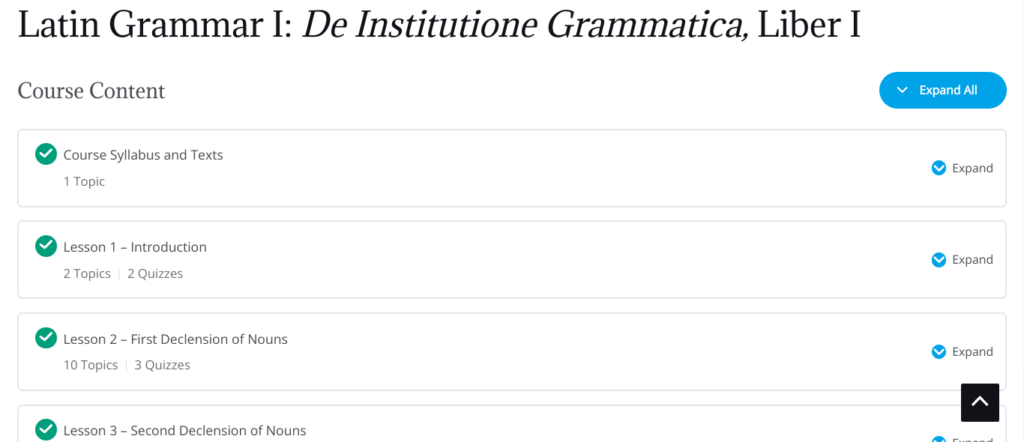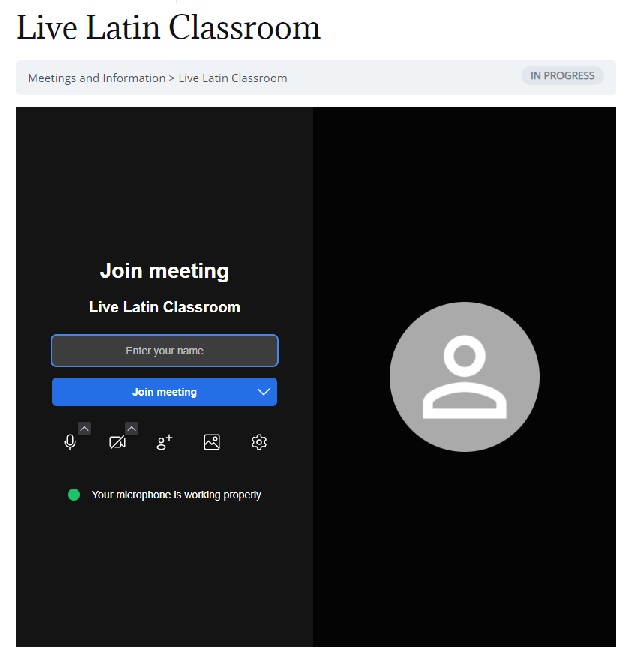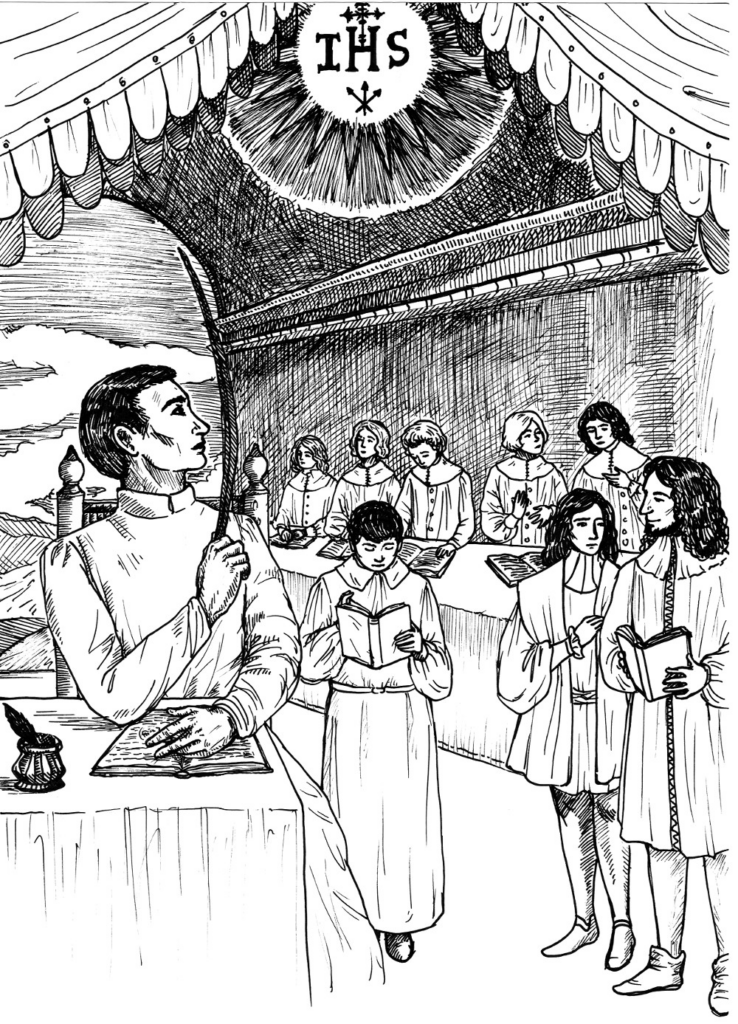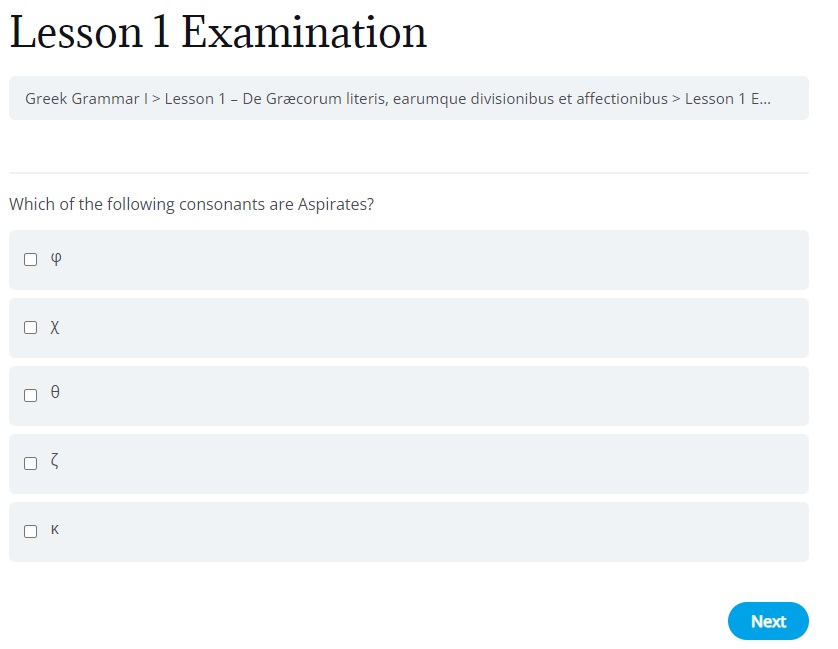

We offer a true course of study in the seven classical liberal arts with course work directly translated from the original Latin and Greek sources and formatted specifically to meet the needs of today’s students.
Further, when our students turn to commentators to aid their study of core liberal arts texts, they study with the best Catholic philosophers. For instance, we provide original translations of the commentaries of St. Severinus Boethius and St. Thomas Aquinas to aid our students in their study of Logic in Porphyry and Aristotle.
In addition, when discrepancies arise in different versions of texts, or the text itself presents an ambiguity, we utilize the manuscript tradition to:
(1) ensure our students study a sound version of the text and


(2) offer our students accurate interpretation informed by textual glosses.

We present the study of the seven classical liberal arts by means of an online LearnDash classroom (pictured above), which includes online texts, classes, assignments, and examinations. We also plan the future publication of course textbooks.
Each lesson text presents the content clearly, in newly formatted text. Here is an example of a lesson from Porphyry’s Isagoge, the first course in Logic. In addition to the original Greek, there also appears Boethius’ Latin translation, and a literal English translation of the Greek.


Our online quizzes and examinations thoroughly test key content to help ensure student mastery of the curriculum. Here is a sample question from a Latin Grammar II quiz.
Whatever the benefits of distance learning programs, students sometimes feel isolated. In addition, they lack the opportunities to interact with peers and instructors.
We offer students the chance to participate in live classes, both to review and apply grammar rules from the Latin Grammar coursework, as well as to practice translating Latin passages from our Humanities courses.



Classical Latin Grammar is called Ianua Artium, i.e., the entrance of the arts. Grammar is foundational in many ways for later study. It may go without saying that all Latin grammar programs are not equal; what characteristics, then, should parents look for when selecting one?
If Grammar is to function as a liberal art, it must include a clear deductive presentation of grammar rules. Although it may only be implicit (since such a consideration should not be the focus of young students), the program itself should present Grammar as a system founded in fixed rules that directly relate to the order present in reality.
With this, however, such rules were certainly not always followed, and in some areas, were regularly ignored by Latin writers. For this reason, parents should seek a Latin grammar curriculum that recognizes this diversity in practice and can point to examples of this in the greatest Latin authors to help students understand such matters clearly.
The three books De Institutione Grammatica by the Jesuit Emmanuel Alvarez fulfill both of these. Our Latin Grammar program is taken directly from our original translation of Alvarez’ Latin original. Our students benefit not only from his systematic presentation of Latin grammar rules and the philosophy that underpins those, but also from the amazingly large treasury of Latin examples that Alvarez shares to illustrate each rule.
While the three books of Alvarez form the core of our Latin program, we offer supplemental coursework in Latin reading, vocabulary, and writing, as well as our Latin Humanities enrichment coursework.


Our Latin Reading coursework includes Latin Reading I: The Book of Genesis, Latin Reading II: The Epistles of Cicero, and Latin Reading III: The Aeneid of Virgil. Pictured above is a sample imitation lesson in which students practice the Latin composition of an epistle and then compare the discrepancies between their own Latin and the Ciceronian original.

Our Latin Vocabulary course presents students a wide variety of Latin words to describe the natural world as well as the everyday activities of human life.
Although not a direct part of the liberal arts curriculum, the readings associated with the humanistic movement in Renaissance education in general, and Jesuit education in particular, offer many benefits.
Our Latin and Greek Humanities courses offer students graded translation assignments through (1) additional self-paced coursework for advanced students and (2) homework assignments for live classes.
We draw our selection of humanities readings directly from Renaissance Jesuit textbooks.

Continuing the Ascent

St. Thomas Aquinas calls Logic “the discipline of the disciplines”. The manner in which students learn logic is very important, as it involves not only the nature of the connection between our ideas and reality, but also the manner in which our ideas connect with each other. Merely offering coursework in Porphyry or Aristotle is not sufficient, as their thought is handled in various ways. For example, even in a famous Jesuit University like Coimbra, there developed early a change from teaching the ideas of Aristotle and Aquinas to learn from them to using the words of those thinkers as jumping off points for teaching new, different ideas to criticize them.
Perhaps the most misunderstood classical liberal art, Classical Arithmetic studies discrete quantity (multitude). Beginning with unity, and progressing by necessary steps, this art demonstrates the beautiful order present in the natural arrangement of number, which serves as the “root and mother” of Music, Geometry, and Astronomy.
This liberal art should not be confused with, and cannot be replaced by, the practical arithmetic children study to learn the four basic operations: addition, subtraction, multiplication, division.


Students study the books of Euclid, as presented by the Jesuit Mathematician Andre Tacquet. As in Classical Arithmetic, in Classical Geometry students begin with a unity (the point), and proceeding through necessary connections, develop certain knowledge.

Pictured here is a sample worksheet page showing Proposition 18 from Book I.

Following the approach of Alvarez for Latin, we offer the three books of Greek Grammar by the Jesuit Jacob Gretser. This coursework will prepare students for reading the New Testament, eastern Church Fathers like St. John Chrysostom, the philosophers Porphyry, Plato, and Aristotle, and authors like Homer.

Our Greek Reading coursework includes Greek Reading I: The Acts of the Apostles, Greek Reading II: The Anabasis of Xenophon, and Greek Reading III: The Odyssey of Homer. Pictured to the right is the second lesson from Greek Reading I.
Reaching a Peak
III. Rhetoric, Music, Astronomy – Completing the climb
The classical liberal art Rhetoric teaches skill in the unity composed of the ideas to be communicated, the words signifying the ideas, both absolutely and in relation to one another, the speaker or writer himself, and the audience. This integrity, of course, rests not on the empty eloquence of the proclamation itself, but on its confirmation to the truth of the ideas and the moral rightness of the speaker.


Just as literary study can be a meaningful supplement to that of the linguistic arts Grammar, Logic, and Rhetoric, musical study of various periods (ancient, classical, romantic, etc.) can be powerful auxiliary means to follow that of the liberal art Music. This art, whether it is applied to auditory music or not, demonstrates the order present in relative quantity, which offers many important insights regarding unity, equality, inequality, priority, posteriority, as well as harmony.
Although it is obvious that modern astronomy has reached far beyond the reach of the classical art Astronomy, the benefit of studying this art is clear: beginning with the principles of the art Arithmetic, proceeding with those of the art Geometry, the student of this art develops a systematic understanding of the cosmos, inasmuch as it is observable at the level of unaided observation.


This provides the natural precursor for what is then fulfilled by the Church’s liturgical year, and consequently, demonstrates the supernatural fulfillment of the order of time present to humans in their daily lives in the natural world.
For more information, contact: info@septemartesliberales.org.
